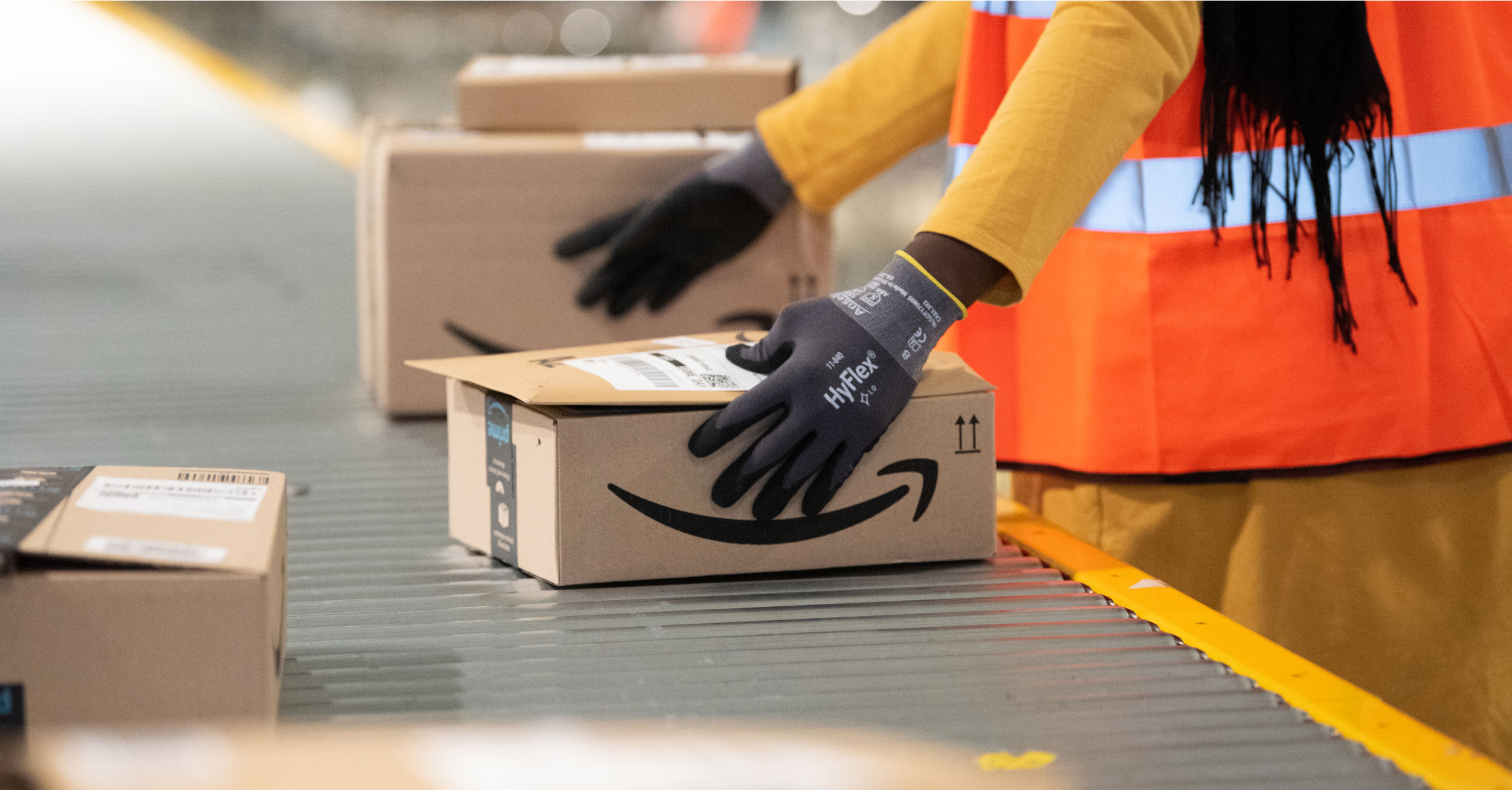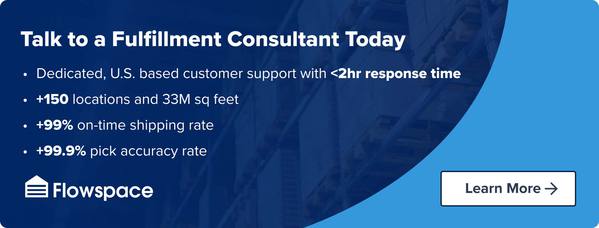Updated March 17, 2024
What Is Amazon FBA (Fulfillment by Amazon)?
Amazon FBA (Fulfillment by Amazon) is a service offered by Amazon that enables online sellers to store their products in Amazon’s fulfillment centers. Amazon then takes responsibility for picking, packing, shipping, and providing customer service for these products.
With FBA, an Amazon seller can benefit from Amazon’s huge network of order fulfillment centers to reach more customers, increase sales, and improve the customer experience. FBA also allows an Amazon seller to offer Amazon Prime shipping, which can attract customers.
An Amazon FBA seller sends their products to Amazon’s fulfillment centers, and when a customer places an order, Amazon picks and packs the product, ships it to the customer, and handles any customer service issues that may arise. This means that the Amazon FBA seller outsources the logistics and customer service aspects of the business to Amazon.
Amazon charges an FBA fee for the service, which includes the Amazon warehouse storage fee , fulfillment fees, and other fees. The FBA fee varies depending on the size and weight of the product, as well as the time it spends in Amazon warehouse storage.
How Does Amazon FBA Work?
Amazon FBA is particularly appealing for sellers looking to tap into the “Amazon effect,” which refers to the significant impact Amazon has on the e-commerce landscape, including consumer expectations for fast shipping and superior customer service. When a customer places an order for a product, Amazon picks, packs, and ships the product to the customer on behalf of the seller.
The fulfillment process
Here is a step-by-step breakdown of the Amazon FBA fulfillment process:
- A seller enrolls in Amazon FBA and sends their products to Amazon’s fulfillment centers.
- Amazon receives the products and stores them in its fulfillment centers.
- The seller lists their products for sale on Amazon’s marketplace, indicating that they will be fulfilled by Amazon.
- A customer places an order for a product from the seller’s listing on Amazon.
- Amazon’s system automatically selects the product from its fulfillment center, packs it, and ships it to the customer.
- Amazon handles any customer service issues, such as returns or refunds.
- Amazon pays the seller the sale price, minus the fees charged for the FBA service.
Fees and costs
Amazon charges fees for the storage and fulfillment of products, as well as additional fees for certain services. The fees vary depending on the size and weight of the product, as well as the time it spends in storage.
Some of the costs and fees include fees for storing products in its fulfillment centers; fees for picking, packing and shipping products; fees for removing products from the fulfillment centers; referral feeds; and fees for labeling and packaging products.
Storage fees are generally paid monthly and vary depending on the size and weight of the product, as well as the time it spends in storage. There are also additional fees for long-term storage of products that have been in storage for more than 365 days.
Pros of Amazon FBA
While comparing Amazon FBA and FBM, it’s essential to consider the pros and cons of selling on Amazon with FBA in the first place. Amazon FBA offers several benefits and advantages for online sellers, including a streamlined fulfillment process, access to Amazon Prime customers, and customer service and returns management.
Streamlined fulfillment process
Rather than fulfilling each individual order placed on Amazon’s marketplace, Amazon FBA lets brands send products in bulk to Amazon’s warehouses. This means fewer steps in the fulfillment process and fees up a seller to focus on other aspects of the business. Amazon FBA also offers multi-channel fulfillment, which allows sellers to fulfill orders from their own website or other marketplaces using Amazon’s fulfillment network.
Access to Prime customers
With more than 200 million Prime members worldwide, Amazon Prime offers brands a built-in audience that is ready to purchase Prime-eligible products. Products fulfilled by Amazon are eligible for Amazon Prime, which can attract more loyal and repeat customers.
Customer service and returns handling
Amazon handles the logistics and customer service aspects of the business, which can result in a better customer experience and higher customer satisfaction.
More Buy Box power
Winning the Amazon Buy Box is significantly influenced by fulfillment efficiency, with factors such as speed, cost, convenience, and reliability of shipping and delivery playing pivotal roles. Not surprisingly, Amazon views its own Fulfillment by Amazon (FBA) service as setting the standard for these metrics, often outperforming Fulfillment by Merchant (FBM) on these fronts. FBM sellers can improve their odds of winning the Buy Box by offering Seller Fulfilled Prime, explained below.
Potential Amazon SEO advantages
Amazon keeps the workings of its search algorithm under wraps, not disclosing the specifics of how it operates. Despite the lack of official confirmation from Amazon, it’s widely accepted within the industry that using FBA is a factor that influences rankings in search results.
Cons of Amazon FBA
While Amazon FBA offers many benefits, there are also some potential downsides that online sellers should consider before using the service. These include high fees and storage costs, limited control over inventory and branding, and inventory commingling issues.
High fees and storage costs
Amazon charges fees for the storage, fulfillment, and other services associated with FBA. These fees can add up and impact the profitability of the business. Amazon’s fulfillment fees have increased 30% since 2020 through many small fee increases. A one pound item that cost $3.48 to fulfill in 2020 now costs $4.75 in 2023—an increase of almost 40%.
Limited control over inventory and branding
When using FBA, sellers give up control over the fulfillment and shipping process, which can be a concern for some sellers who prefer to have more control over these aspects of their business. Amazon will also sometimes place limits on how much inventory a brand can send into its warehouses, which can result in brands running out of stock—and losing customers.
Inventory commingling issues
Inventory commingling is a feature of Amazon FBA that allows multiple sellers to store their inventory together in the same fulfillment center. This can potentially result in products from different sellers being mistakenly mixed together. Some of the specific concerns here are counterfeit products, lost or damaged products, quality control issues, and liability concerns.
What Is Amazon FBM (Fulfillment by Merchant)?
Amazon FBM is when sellers fulfill their own orders instead of using Amazon’s own fulfillment centers. With FBM, sellers store their inventory in their own warehouses or facilities and ship orders directly to customers when they receive an order on Amazon’s marketplace.
FBM gives sellers greater control over their inventory and shipping processes. It’s generally a good option for sellers who have the resources to handle fulfillment themselves, or who want to offer customized shipping options. It can also be a good option for sellers who are just starting out and don’t have enough sales volume to justify the cost of using Amazon’s fulfillment centers.
However, FBM does require sellers to handle all aspects of fulfillment, including picking, packing, and shipping orders, as well as handling customer service inquiries and returns. Sellers must also meet Amazon’s performance standards for shipping and customer service in order to maintain their seller account in good standing.
What is Seller Fulfilled Prime (SFP)?
Seller Fulfilled Prime (SFP) is a variation of FBM that allows sellers to deliver directly to domestic Prime customers from their own warehouse. By displaying the Prime badge on their offers, sellers commit to fulfilling orders with one-day and two-day delivery at no additional charge for Prime customers. To be eligible for Amazon SFP, sellers must meet strict performance standards, including free one-day and two-day delivery for Prime customers, free nationwide standard shipping for all customers, and other criteria such as on-time delivery rate, valid tracking rate, and a low seller-initiated cancellation rate.
How Does Amazon FBM Work?
An FBM Seller lists their products on Amazon’s marketplace and then fulfill the orders themselves.
The fulfillment process
Here is a step-by-step breakdown of the Amazon FBM fulfillment process:
- First, the FBM seller lists their products on Amazon and create their seller account, which includes setting shipping rates and policies.
- When a customer orders a product, the order is sent to the seller for fulfillment.
- Sellers then pick, pack, and ship the order themselves.
- After the order is shipped, sellers must enter tracking information into their seller account to update the customer on the status of their order.
- Sellers handle any customer service inquiries that come up.
Fees and costs
The main cost difference between FBA and FBM is that with FBM, the seller is responsible for paying for all of the fulfillment costs—labor, materials, and equipment, to name a few. FBM sellers are still responsible for paying the referral fee for each item sold on Amazon’s marketplace. The referral fee is a percentage of the item’s sale price and varies depending on the category of the product.
Pros of Amazon FBM
Amazon FBM can be a great choice for sellers looking for more control, lower fees and more flexibility.
Lower fees and storage costs
Because sellers using Amazon FBM don’t use Amazon warehouses, they do not pay Amazon for storage. Amazon also charges them fewer fees overall.
Greater control over inventory and branding
Sellers using Amazon’s warehouses might have limits on the amount of inventory they can store there, which can lead to stock outs if there’s a big increase in demand. With FBM, sellers have total control over inventory. FBM also allows sellers to include their own branding on the packaging materials, which can help to enhance brand recognition and customer loyalty.
Flexibility in shipping options
FBM allows sellers to fulfill and ship orders in a way that works best for their business. Sellers may be able to offer faster shipping times than Amazon’s fulfillment centers. This can be especially important for sellers who offer products that customers need quickly.
Cons of Amazon FBM
While Amazon FBM can be a great option for some sellers, it can be time-consuming, provide limited access to Prime customers, and require greater responsibility for sellers.
Time-consuming fulfillment process
FBM requires sellers to handle – either in-house or with a fulfillment partner – every aspect of order fulfillment, including picking, packing, and shipping. This can be time-consuming, especially for sellers with a large volume of orders.
Limited access to Prime customers
One of the benefits to selling on the Amazon platform is access to its huge customer base. Products fulfilled through FBM are not eligible for Amazon Prime, which can be a disadvantage for sellers who rely on Prime to attract customers.
Responsibility for customer service and returns
With FBM, brands maintain responsibility for all aspects of the fulfillment process, and that includes customer service and returns. These can also be time-consuming aspects of the fulfillment process.
Things to Consider When Comparing Amazon FBA vs FBM
Fulfillment speed and efficiency
FBA typically offers faster shipping speeds than FBM, which can be important for brands that want to provide a good customer experience. However, FBM sellers can potentially offer faster or more efficient shipping if they have smart shipping processes and reliable partners in place. It really depends on what the brand has set up already, so it’s important for brands to look carefully at their current process and shipping options to decide between FBA and FBM.
Cost comparison
One of the biggest differences between FBA and FBM is the cost of fulfillment. FBA fees include storage, picking, packing, and shipping, while FBM fees are only for the shipping. However, those are just the fees paid to Amazon. Brands should compare the total costs of both options to determine which one is more cost-effective for their business.
Customer service and returns management
Brands using FBA can take advantage of Amazon’s customer service for fulfillment-related issues. With FBM, brands are responsible for handling customer service inquiries related to fulfillment. This can be an advantage when a seller prioritizes the customer experience.
Control over branding and inventory management
FBM offers more control over the fulfillment process since brands handle everything from storage to shipping. This can be a benefit for brands that want to have more control over their product inventory management , brand image, and customer experience.
Flowspace: A Reliable Amazon FBA Alternative
Some brands might love the increased control and lower fees of FBM but also appreciate the efficiency and time-saving nature of FBA. Which option should they choose?
There’s a third option. That’s using Flowspace to handle fulfillment as your Amazon FBA alternative . Flowspace enables sellers to readily respond to demand without exerting the extra cost, time, and effort of complying with Amazon’s strict rules and excessive fees.
Benefits of using Flowspace for Amazon Fulfillment
Flowspace provides a range of benefits for Amazon sellers looking for flexible and cost-effective warehousing and Amazon direct fulfillment solutions.
Flowspace connects merchants to a national fulfillment network that enables sellers to offer consistently reliable, transparent, cost-effective fulfillment, from every channel. Flowspace provides the freight, storage, pick, pack and ship, and warehousing services brands need to power omnichannel fulfillment, with industry-leading on-time shipping rates. Advanced software offers a centralized platform to configure order rules and operations, providing at-a-glance inventory and order visibility across every channel.
Flowspace platform also integrates seamlessly with Amazon integration , so picking, packing, and shipping of Amazon orders are handled directly from a network of optimally located fulfillment centers.
Unlike Amazon’s warehouses, Flowspace has no space minimums, so brands eliminate the issue of overpaying for unneeded space and improve the logistics network. Flowspace offers flexible storage options to accommodate the changing needs of Amazon sellers. This includes short-term and long-term storage, as well as the ability to scale up or down based on inventory levels.
Flowspace offers competitive pricing for storage and fulfillment services, which can help Amazon sellers to save money compared to using Amazon’s own fulfillment services.
Transitioning from Amazon FBA or FBM to Flowspace
Brands interested in transitioning from Amazon FBA or FBM to Flowspace first need to assess current inventory levels, order volume, and fulfillment needs. This will help to determine the appropriate storage and fulfillment services needed from Flowspace.
The next step is to work with a Flowspace fulfillment consultant to discuss storage and fulfillment plans. With a nationwide network encompassing more than 33 million square feet of space, Flowspace can help you determine the best short-term and long-term options for your brand, with limitless access to scale up or down based on inventory levels or needs. Flowspace offers a variety of fulfillment options, including custom packaging and shipping labels. Brands should determine the fulfillment specifications that work best for them and ensure that their products meet the necessary packaging and labeling requirements.
Once an agreement is in place, brands can access Flowspace’s fulfillment management platform, including inventory and order management systems, and connect all their shopping carts and sales channels. Once the inventory is in place, orders can start to be fulfilled by Flowspace.
If you’re interested in a fulfillment alternative to Amazon FBA or FBM, get in touch with Flowspace today!








